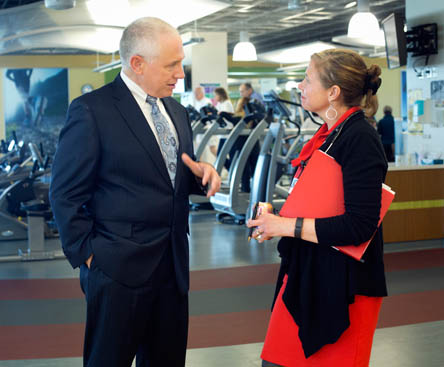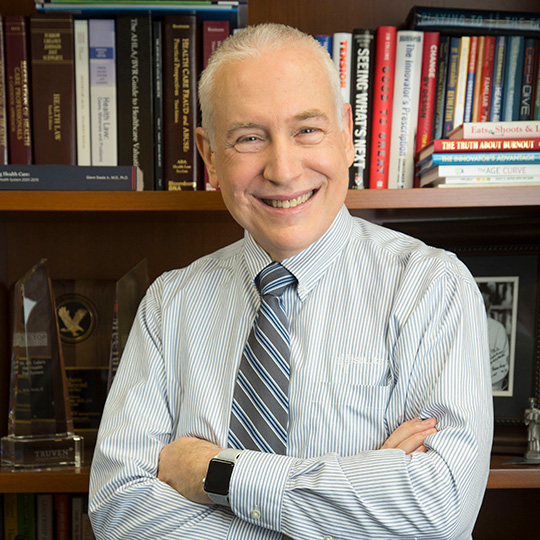St. Luke’s MetSyn Efforts Show Just How Complicated Healthcare Transformation Is
What happens when a group of committed, empowered patients and equally involved medical professionals score a clear health victory, but it’s not something that health care is ready for?
It’s a question increasingly facing St. Luke’s Health System, which has moved energetically in the direction of accountable care and population health, and one other hospitals and health systems across the country also are beginning to grapple with.
Over the past several years that St. Luke’s has been part of CMS’ Medicare Shared Savings Program, sometimes in connection with that program and just as often outside of it, the organization has been piloting and adopting new programs, innovations, improvements, and efficiencies on all levels, everything from how St. Luke’s Health System is governed to how we can improve outcomes for patients having certain surgical procedures.
The work has been important to St. Luke’s for one reason only: To improve the health of people in our region, which is the organization’s mission statement.
Successes along the journey of healthcare transformation, for St. Luke’s and for many other hospitals and health systems, are stretching people, partner organizations, and businesses.
Here’s a St. Luke’s example:
Dr. Jennifer Shalz, medical director of St. Luke’s Heart Health and Rehabilitation, and a team of dieticians, exercise physiologists, a licensed clinical social worker, and health coaches have been working for the past year with groups of St. Luke’s employees in two Metabolic Syndrome (MetSyn) Prevention Clinic Program pilots.
A third of American adults have a clustering of certain risk factors, called metabolic syndrome, that are associated with a five-fold increase in the development of diabetes, a two-fold increase in development of coronary artery disease and an increase in all-cause mortality, gallstones, asthma, sleep disordered breathing, and some forms of cancer. These risk factors include even borderline high blood pressure and blood sugar as well as cholesterol abnormalities and an increased waist size.

The program Dr. Shalz and her colleagues designed is meant to provide intensive lifestyle change support and has included information, education, and resources about nutrition, cooking, exercise, and emotional health, delivered through lectures, coaching, accountability structures, self-tracking with feedback, and supervised group exercise sessions. Participants met twice weekly for the duration of the program.
Both 12-week programs hit it out of the park. Participants lost weight, reduced their waist circumference, and improved their body mass index, blood sugar, blood pressure, triglycerides, anxiety, depression, and quality of life, all in statistically significant measure.
Participants formed communities. Even after the formal pilot clinics have ended, they continue to meet to work toward their common goals. And in so doing, many have continued to lose weight and improve their health.
The first group had lost 7 percent of their initial body weight at 12 weeks. They continued to lose weight as a group and had lost 9 percent of their initial body weight five months after the program formally concluded. The second cohort had lost 6 percent of their initial body weight at the conclusion of the second pilot.
Dr. Shalz’s clinic participants succeeded and the clinicians succeeded – and the calls came pouring in. Colleagues across St. Luke’s Health System had great ideas for how numerous others, receiving care across multiple specialty areas, could benefit, including people with degenerative joint and spine problems, fatty liver disease, atrial fibrillation, some cancer survivors, women seeking improved fertility and healthier pregnancies, and men treated with hormone therapy for prostate cancer.
And now Dr. Shalz and her team, patients, payers, and St. Luke’s Health System must figure out how to pay for this very intensive approach to a serious and difficult health condition. The puzzle is a microcosm of the challenge facing hospitals and health systems seeking to share better health with patients and to make progress toward better care and lower costs.
When viewed in the context of the problem, and such expenses as the ongoing costs of treating diabetic complications and coronary artery disease, only two of the probable outcomes of untreated metabolic syndrome, are healthcare payment models willing to invest directly in high-risk patients when weight loss is at the center of the treatment recommendations and when “care as usual” – recommending that a person eat less and exercise more – is clearly not working?
“Behavior change is hard, especially in our obesogenic environment,” Dr. Shalz said. “A multidisciplinary team by your side works to enable the self-efficacy necessary to form lifelong habits that will decrease risk.”
Dr. Shalz believes that a future Metabolic Syndrome Prevention Program might be built around a core healthy lifestyle curriculum offered to all participants with add-on components coordinated by the various departments specific to certain populations.
It’s also possible that the staff could work with cohorts at fitness centers belonging to St. Luke’s community partners, which could broaden a MetSyn program’s reach and effectiveness.
There’s also reason to think that extending the length of the program would make it even more effective. More touchpoints over a longer period of time, the team believes, could cement new healthier habits, and might give participants the chance to focus more on mindfulness meditation and accountability, two particularly helpful program components. St. Luke’s planners are trying to figure out how a longer pilot might be funded.
“What would be ideal is if we could deepen our curriculum and make it longer,” Dr. Shalz said.
In many respects, rather than answering questions, the MetSyn effort has raised a whole host of new ones, some far more complicated than the already-complicated questions around how to operate such a program.
How does society go about encouraging truly well workplaces? How do you change a work environment? Might people who complete such a program influence their personal circles for a spillover effect? Could a MetSyn model be built to address entire families, including children at risk for obesity-related disease? How will America pay to solve this particular health threat? How can people stay engaged in a multi-pronged health matter over a lifetime?
Over and over, Dr. Shalz and her team have been told that the clinics have changed lives. The challenge is making a life-changing, life-saving approach that is very time- and labor-intensive with no clear payment path scalable and sustainable. And the team isn’t at all sure that a pared-back program would be nearly as effective.
“It’s basically grassroots right now,” said Audrey Mitchell, the team’s licensed clinical social worker. “If we did this on a larger scale, what would we have to create?
“What we’re doing feels like magic,” she said. “It’s magical.”
About The Author

David C. Pate, M.D., J.D., previously served as president and CEO of St. Luke's Health System, based in Boise, Idaho. Dr. Pate joined the System in 2009 and retired in 2020. He received his medical degree from Baylor College of Medicine in Houston and his law degree from the University of Houston Law Center.
